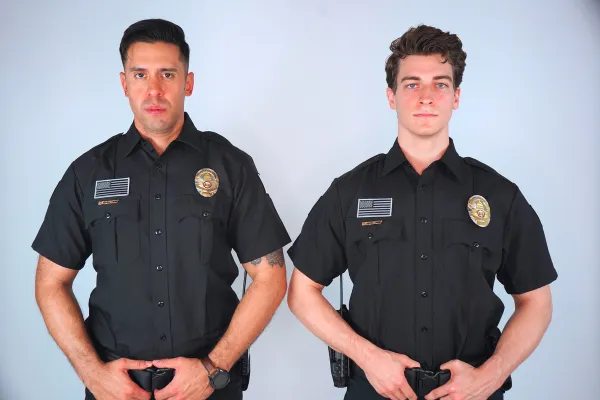Blog & News

Event Security: Ensuring Safe and Successful Gatherings
Event Security: Ensuring Safe and Successful Gatherings
Whether you’re organizing a concert, conference, festival, or corporate event, comprehensive event security is essential to protect attendees, staff, assets, and your reputation. Inadequate planning or staffing can lead to safety incidents, liability exposure, and operational chaos. At Steel Bison Security, we specialize in tailored event security solutions that cover every detail—from risk assessment and crowd management to emergency response and post-event analysis.
1. The Importance of Event Security
Events bring together large numbers of people in a confined space, often with expensive equipment, temporary structures, and elevated stress levels. Effective security ensures:
Attendee Safety: Preventing injuries, assaults, and panic situations.
Asset Protection: Safeguarding equipment, merchandise, and infrastructure.
Liability Reduction: Demonstrating due diligence to insurers and regulators.
Reputation Management: Delivering a smooth, incident-free experience that builds trust and loyalty.
Regulatory Compliance: Meeting local requirements for crowd sizes, fire safety, and emergency access.
Without a structured security plan, even a minor dispute or medical emergency can escalate into a crisis, jeopardizing your event and exposing you to legal and financial repercussions.
2. Pre-Event Risk Assessment and Planning
2.1. Site Survey
Conduct a detailed walkthrough of the venue—indoors and out—to identify potential hazards:
Perimeter Vulnerabilities: Fencing gaps, unmonitored entrances, poor lighting.
High-Traffic Zones: Ticket booths, entry points, restrooms, concession areas.
Emergency Exits: Accessibility, signage, and potential obstructions.
2.2. Threat Analysis
Evaluate possible risks, including:
Crowd-Related: Stampedes, overcrowding, disorderly behavior.
Security Breaches: Unauthorized entry, gate-crashers, ticket fraud.
Violent Incidents: Fights, active assailants, terrorism.
Environmental: Weather emergencies, fires, structural failures.
2.3. Security Plan Development
Your written plan should cover:
Security Zones: Define “public,” “staff only,” “VIP/backstage,” and “secure storage” areas.
Patrol Routes & Posting: Mobile patrols versus static posts at key locations.
Communications Protocol: Radio channels, code words, escalation procedures.
Incident Command Structure: Chain of command for reporting and decision-making.
Document all procedures in a comprehensive Event Security Operations Manual shared with every team member.
3. Staffing and Training
3.1. Adequate Guard Ratios
Industry benchmarks suggest 1 guard per 100–250 attendees, adjusted for event type, risk level, and venue layout. Smaller, rural events may require fewer staff while high-profile concerts demand a larger, specialized team.
3.2. Specialized Roles
Access Control Officers: Manage entry points and verify credentials.
Roving Patrols: Observe crowd dynamics, identify disturbances, and check equipment.
VIP Protection: Escort high-value guests and manage secure corridors.
Emergency Response Teams: Trained in first aid, crowd evacuation, and fire watch.
3.3. Training Requirements
All security personnel should receive:
Pre-Event Briefings: Site-specific hazards, communication protocols, chain of command.
De-Escalation & Conflict Resolution: Techniques to calm agitated individuals without force.
First Aid/CPR Certification: Complying with American Red Cross or equivalent standards.
Active Threat Response: Run, hide, fight protocols aligned with Department of Homeland Security guidelines.
Regular drills—both tabletop exercises and full-scale simulations—build muscle memory and confidence.
4. Access Control and Credentialing
4.1. Ticketing Integration
Coordinate with your ticketing provider to use:
Barcode/QR Code Scanners: Prevent re-entry fraud by invalidating tickets once scanned.
RFID Wristbands or Badges: Speed up ingress and enable zone-based access control.
4.2. Credential Tiering
Issue distinct credentials for:
General Admission
Staff & Vendors
Performers/Presenters
VIPs & Sponsors
Media
Each tier should grant access only to appropriate security zones.
4.3. Physical Barriers
Use sturdy fencing, barricades, and turnstiles to funnel attendees through controlled checkpoints. For high-risk events, consider drive-up vehicle screening and under-vehicle inspection mirrors.
5. Crowd Management and Traffic Flow
5.1. Entry & Exit Flow
Design one-way foot traffic patterns and multiple ingress/egress points to avoid bottlenecks and reduce wait times.
5.2. Queue Management
Deploy stanchions and signage early to establish orderly lines at ticket booths, concessions, and restrooms.
5.3. Crowd Density Monitoring
Leverage:
On-Foot Observation: Roving security notes any dangerously high concentrations.
CCTV Feeds: Monitor live video to detect surges and divert foot traffic.
Analytics Software: Heat-mapping sensors alert you when capacity thresholds are reached.
5.4. Barrier Planning
Use crush barriers and reinforced fencing in front of stages or VIP areas to prevent crowd surges.
6. Technology and Surveillance
6.1. CCTV Monitoring
Deploy a mix of fixed and PTZ cameras to cover:
Perimeter & Entry Points
High-Value Asset Zones
Backstage and Loading Areas
Crowd Gathering Spots
Integrate feeds with a central monitoring station staffed 24/7 for large multi-day events.
6.2. Access Control Systems
Combine RFID readers, biometric scanners, or keypad panels for staff-only and VIP areas.
6.3. Communication Tools
Equip guards with:
Encrypted Two-Way Radios
Mobile Patrol Apps that log checkpoint visits and incidents in real time.
Mass Notification Systems to broadcast alerts to attendees via SMS or stadium speakers.
7. Emergency Response and Medical Preparedness
7.1. On-Site Medical Teams
Contract with EMTs or paramedics and establish a clearly marked Medical Triage Area close to first-aid posts.
7.2. Evacuation Planning
Identify primary and secondary evacuation routes, assembly points, and “safe zones” for various scenarios—fires, weather events, or active threats.
7.3. Fire Watch & Hazard Mitigation
During setup, monitor hot work (welding, cutting) and enforce fire watch protocols in compliance with NFPA 1 Fire Code.
7.4. Incident Command System (ICS)
Implement an ICS structure—Incident Commander, Operations, Logistics, Planning, and Finance/Admin—to coordinate multi-agency responses with local law enforcement and fire departments.
8. Vendor and Contractor Coordination
8.1. Security Briefings
Include all vendors, caterers, production crews, and contractors in security orientations—covering credentialing, site access, and emergency procedures.
8.2. Delivery & Load-In Control
Schedule deliveries during low-traffic windows and assign security escorts for high-value equipment.
8.3. Shared Communication
Provide vendors with radios or access to your Event Command Center’s communication channels to report incidents or request assistance quickly.
9. Legal, Insurance, and Regulatory Compliance
9.1. Permits and Licenses
Obtain all required permits—public assembly, alcohol service, noise variances, and fire-lane access—from local authorities.
9.2. Insurance Requirements
Verify that your security partner carries:
General Liability
Event Cancellation
Liquor Liability (if applicable)
Workers’ Compensation
9.3. ADA and Accessibility
Ensure security checkpoints and egress routes accommodate attendees with disabilities, in line with ADA regulations.
9.4. Privacy and Data Protection
If using facial recognition or attendee tracking, comply with relevant privacy laws and clearly communicate data use policies.
10. Post-Event Review and Continuous Improvement
10.1. Debrief and After-Action Report
Within 72 hours, convene a debrief with:
Security Leads
Client/Organizer Representatives
Local First Responders (if engaged)
Document:
Incident Summaries
Response Timelines
Lessons Learned
Recommendations for Future Events
10.2. Attendee Feedback
Survey attendees on perceived safety and areas for improvement. Address concerns—such as long wait times or poorly marked exits—in your next plan.
10.3. Update SOPs and Training
Incorporate new protocols, revise patrol routes, and schedule refresher training for any identified gaps.
11. How Steel Bison Security Can Support Your Event
At Steel Bison Security, we offer end-to-end event security services:
Comprehensive Risk Assessments to tailor your security plan.
Licensed & Trained Personnel in crowd management, emergency response, and de-escalation.
Technology Integration—CCTV monitoring, mobile patrol apps, and mass notification systems.
Medical and Fire Watch Coordination with certified EMTs and NFPA-compliant fire watchers.
Vendor & Contractor Oversight to maintain site integrity.
Incident Command Support for seamless liaising with local authorities.
After-Action Reporting to continuously refine your security strategy.
Learn more on our services page or schedule a consultation via our contact page.
12. Conclusion
Event security is a complex, multi-layered discipline that requires meticulous planning, professional staffing, and seamless coordination with technology and local authorities. From initial risk assessments and credentialing to crowd management, emergency response, and post-event analysis, every element must be thoughtfully designed and executed. By partnering with an experienced, licensed provider like Steel Bison Security, you ensure that your event runs smoothly, attendees feel safe, and you mitigate both tangible and intangible risks. Invest in comprehensive event security today to deliver memorable—and secure—experiences for everyone involved.
Ensure the success and safety of your next event. Contact Steel Bison Security for expert event security planning and execution that you can trust.

EMAIL ADDRESS
OFFICE NUMBER
OFFICE ADRESS
(WA) 11900 NE First St STE 3066, Bellevue, Wa 98005
(WY) 30 N. Gould St STE R, Sheridan, Wy 82801
Copyright 2024 Steel Bison Security Services
